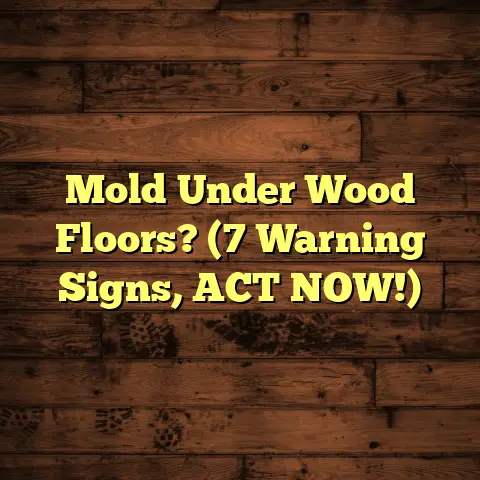Best Scratch-Resistant Wood: Options? (Avoid These!)
Have you ever wondered how to choose the best wood for your flooring or furniture that can withstand the wear and tear of daily life while maintaining its beauty and integrity?
Choosing the right wood for your flooring and
furniture is a big deal, especially in high-traffic
areas or homes buzzing with kids and pets.
I’ve seen firsthand how the wrong choice can
lead to a scratched-up mess, while the right
one can stand the test of time, looking gorgeous
for years.
Think about it: flooring takes a beating from
foot traffic, dropped toys, and pet claws.
Furniture isn’t immune either – think of coffee
tables hosting game nights or dining tables
handling family meals.
The right wood can
handle all of this.
So, what exactly does “scratch resistance” mean
when we’re talking about wood?
It’s basically
how well a wood can withstand being marked or
damaged by sharp objects or abrasive surfaces.
A scratch-resistant wood will keep its smooth,
unblemished surface for longer, meaning less
maintenance and a better-looking home.
In this article, I’m going to walk you through
the best options for scratch-resistant woods and
point out the ones you should probably steer
clear of.
We’ll dive into what makes a wood
scratch-resistant, explore some top contenders,
and even look at how different finishes can play
a role.
Ready?
Let’s get started!
Understanding Scratch
Resistance in Wood
Alright, let’s get into the nitty-gritty of
what makes a wood scratch-resistant.
It’s not
just about one thing; it’s a combination of
factors all working together.
Factors Influencing
Scratch Resistance
Here’s what I look at when assessing a wood’s ability to resist scratches:
-
Wood Hardness: This is the big one.
Harder woods are naturally more resistant to
scratches and dents. -
Grain Structure: A tighter, more uniform
grain can help distribute pressure and reduce
the likelihood of scratches. -
Finish: The type of finish applied to the
wood can significantly enhance or diminish
its scratch resistance.
The Janka Hardness Test
The Janka hardness test is the industry standard
for measuring the resistance of a sample of wood
to denting and wear.
It measures the force
required to embed a .444 inch steel ball to half
its diameter into the wood.
The higher the
number, the harder the wood.
Here’s a quick look at some common wood species and their Janka ratings:
Source: Wood Magazine
As you can see, there’s a wide range.
Brazilian
Cherry is significantly harder than Red Oak,
which in turn is much harder than Pine.
This
directly translates to how well they’ll resist
scratches in your home.
The Role of Finishes
Don’t underestimate the power of a good finish!
It’s like a shield for your wood.
Here are a few
common types:
Polyurethane: A super durable, plastic-like
finish that provides excellent scratch and
water resistance.
It’s a popular choice for
floors.-
Oil-Based Finishes: These penetrate the
wood and offer a more natural look.
While they might not be as scratch-resistant
as polyurethane on their own, they’re easier
to repair. Wax Finishes: These provide a soft,
natural sheen but offer minimal scratch
resistance.
They’re best suited for low-traffic
areas or decorative pieces.
When it comes to scratch resistance,
polyurethane is generally the winner, especially
the water-based versions, which tend to be
harder.
However, the best finish depends on the
wood species and the desired look and feel.
Naturally Scratch-Resistant Woods
Some woods are just naturally tougher than others.
These are the ones I often recommend for
high-traffic areas:
Brazilian Cherry (Jatoba): As you saw
in the table, this is one of the hardest
woods available.
It’s incredibly durable
and resistant to scratches and dents.Hickory: A domestic hardwood that’s
known for its strength and durability.
It’s a
great choice for flooring, especially in
homes with pets.Maple: Another solid domestic option that’s
harder than Oak.
It has a tight grain that
helps resist scratches.
Best Scratch-Resistant
Wood Options
Now, let’s get to the good stuff: the best wood
options for keeping those pesky scratches at bay.
I’ve broken it down into a few categories to
make it easier for you.
Exotic Hardwoods
These woods are sourced from around the world and are known for their unique beauty and exceptional durability.
Brazilian Cherry (Jatoba)
- Characteristics: Rich, reddish-brown color
that deepens over time. Exceptionally hard
and dense. - Durability: One of the most scratch-resistant
woods on the market. - Ideal Uses: Flooring, furniture, and
high-traffic areas. - Maintenance: Requires regular cleaning
and occasional refinishing to maintain its
luster. - My Experience: I once installed Brazilian
Cherry flooring in a busy family home with
three kids and two dogs.
Years later, it still
looked fantastic with minimal scratches.
The
homeowners were thrilled!
Mahogany
- Characteristics: Known for its reddish-brown
color, fine grain, and natural luster. - Durability: While not as hard as Brazilian
Cherry, Mahogany is still a durable wood that
resists scratches well, especially with a
good finish. - Ideal Uses: High-end furniture, cabinetry,
and architectural millwork. - Maintenance: Regular dusting and polishing
will keep Mahogany looking its best. - Things to note: There are many types of
mahogany, and some are more durable than
others.
Be sure to ask about the origin and
species when purchasing.
Teak
- Characteristics: Golden-brown color, oily
texture, and natural water resistance. - Durability: Teak is naturally resistant to
scratches, moisture, and insects. - Ideal Uses: Outdoor furniture, boat decks,
and flooring in areas prone to moisture. - Maintenance: Teak requires minimal
maintenance.
It can be left unfinished to
weather to a silver-gray color or oiled to
maintain its golden hue. - My Observation: I’ve used teak for outdoor
benches and tables, and it holds up incredibly
well against the elements and everyday wear
and tear.
Domestic Hardwoods
These woods are sourced from North America and are generally more readily available and affordable than exotic hardwoods.
Oak (Red and White)
- Characteristics: Red Oak has a reddish tint
and a more open grain, while White Oak has a
more subdued color and a tighter grain. - Durability: Both Red and White Oak are
durable woods that offer good scratch
resistance.
White Oak is slightly harder and
more water-resistant. - Ideal Uses: Flooring, furniture, cabinetry,
and millwork. - Maintenance: Regular cleaning and
occasional refinishing will keep Oak looking
its best. - Pros: Widely available, relatively
affordable, and offers good scratch resistance. - Cons: Can be susceptible to water damage if
not properly sealed.
Maple
- Characteristics: Light color, fine grain,
and smooth texture. - Durability: Hard Maple is a very durable
wood that offers excellent scratch resistance. - Ideal Uses: Flooring, furniture, butcher
blocks, and cutting boards. - Maintenance: Regular cleaning and
occasional refinishing will keep Maple looking
its best. - Pros: Hard, durable, and has a clean,
modern look. - Cons: Can be more expensive than Oak.
Hickory
- Characteristics: Bold grain patterns,
varying colors, and a rustic look. - Durability: One of the hardest domestic
hardwoods, offering excellent scratch and
dent resistance. - Ideal Uses: Flooring, furniture, and
tool handles. - Maintenance: Regular cleaning and
occasional refinishing will keep Hickory
looking its best. - Pros: Extremely durable and has a unique,
rustic appearance. - Cons: Can be more expensive than Oak and
may require special tools to work with.
Engineered Wood and Laminate
These are manufactured wood products that offer a combination of affordability, durability, and scratch resistance.
Engineered Wood
- Characteristics: A core of plywood or
fiberboard topped with a veneer of real wood. - Durability: The durability of engineered
wood depends on the thickness and quality of
the veneer. - Scratch Resistance: Engineered wood with a
thick, high-quality veneer and a durable finish
can be quite scratch-resistant. - Benefits: More dimensionally stable than
solid wood, less prone to warping, and can be
installed over concrete slabs. - My Input: I’ve seen some fantastic
engineered wood floors that look just like
solid hardwood but are more resistant to
moisture and temperature changes.
Laminate Flooring
- Characteristics: A multi-layer synthetic
flooring product that simulates the look of
wood. - Durability: Laminate flooring is known for
its durability and scratch resistance. - Scratch Resistance: High-quality laminate
flooring can be more scratch-resistant than
some solid hardwood options. - Benefits: Affordable, easy to install, and
available in a wide range of styles and colors. - Comparison to Solid Hardwood: While
laminate can be very scratch-resistant, it
doesn’t have the same warmth and feel as solid
hardwood.
It also can’t be refinished. - Things to Note: Look for laminate flooring
with a high AC (Abrasion Class) rating for
better scratch resistance.
Finishing Techniques to
Enhance Scratch Resistance
The right finish can make a big difference in how well your wood stands up to scratches.
UV-Cured Finishes
- What they are: Finishes that are hardened
using ultraviolet (UV) light. - Benefits: Extremely durable, scratch-resistant,
and resistant to chemicals. - My Observation: I’ve noticed that UV-cured
finishes are becoming increasingly popular for
high-end wood flooring and furniture due to
their exceptional durability.
Aluminum Oxide Coatings
- What they are: Finishes that contain tiny
particles of aluminum oxide, a very hard
material. - Benefits: Highly scratch-resistant and
abrasion-resistant. - Common Uses: Often used on prefinished
hardwood flooring to enhance its durability.
Other Modern Finishes
- Ceramic Finishes: These finishes contain
ceramic particles that add to their hardness
and scratch resistance. - Acrylic Finishes: These finishes are
durable, water-resistant, and offer good
scratch resistance.
Woods to Avoid for
Scratch Resistance
Not all woods are created equal when it comes to
scratch resistance.
Some are simply softer and
more prone to damage.
Here are a few you might
want to avoid in high-traffic areas:
Pine
- Characteristics: Soft, lightweight, and
easy to work with. - Scratch Resistance: Very low. Pine is easily
scratched and dented. - Implications: Not a good choice for
flooring or furniture in high-traffic areas or
homes with pets and children. - Effective Uses: Pine can be used effectively
for decorative pieces, wall paneling, or
furniture in low-traffic areas.
Cedar
- Characteristics: Aromatic, reddish-brown
color, and naturally insect-repellent. - Scratch Resistance: Low. Cedar is a soft
wood that scratches easily. - Implications: Not suitable for flooring or
furniture that will see a lot of wear and tear. - Effective Uses: Cedar is a great choice for
closet linings, chests, and other items where
its insect-repellent properties are beneficial.
Poplar
- Characteristics: Soft, lightweight, and
easy to paint. - Scratch Resistance: Low. Poplar is a soft
wood that scratches and dents easily. - Implications: Not a good choice for
flooring or furniture that will be heavily used. - Effective Uses: Poplar is often used as a
paint-grade wood for trim, moldings, and
furniture frames.
Important Note
Even softer woods can be used effectively if
they’re properly protected with a durable finish
and used in low-traffic areas.
It’s all about
choosing the right wood for the right application.
Real-Life Applications and
Case Studies
Let’s take a look at some real-world examples of how scratch-resistant woods are used effectively.
Case Study 1: A Busy Family Home
- The Challenge: A family with three young
children and two large dogs needed flooring
that could withstand heavy foot traffic, dropped
toys, and pet claws. - The Solution: I recommended Brazilian
Cherry flooring with a UV-cured finish. - The Results: Years later, the flooring still
looked fantastic with minimal scratches or
dents.
The homeowners were thrilled with its
durability and beauty. - Homeowner Quote: “We couldn’t be happier
with our Brazilian Cherry floors.
They’ve
held up incredibly well to our crazy family
life.
I would highly recommend it.”
Case Study 2: A High-End Restaurant
- The Challenge: A restaurant needed durable
and attractive tables that could withstand
constant use and spills. - The Solution: I suggested using Teak
tabletops with a durable oil finish. - The Results: The Teak tabletops held up
beautifully to the rigors of restaurant use.
They were easy to clean and resistant to
scratches and stains. - Restaurant Owner Quote: “Our Teak
tabletops have been a great investment.
They
look beautiful and are incredibly durable.
We
get compliments on them all the time.”
Case Study 3: A Pet-Friendly Office
- The Challenge: An office that allowed
employees to bring their pets needed flooring
that could withstand pet traffic and accidents. - The Solution: They chose a high-quality
laminate flooring with a high AC rating. - The Results: The laminate flooring held up
well to pet traffic and was easy to clean.
Employees appreciated the pet-friendly
environment.
Conclusion
Choosing the right wood for your flooring and
furniture is a crucial decision that can impact
the longevity, appearance, and overall value of
your home.
By understanding the factors that
contribute to scratch resistance and carefully
considering your needs and lifestyle, you can
select the perfect wood for your space.
Remember, the best scratch-resistant woods are
typically harder, denser, and finished with a
durable coating.
While softer woods may be
more affordable or aesthetically pleasing, they
may not be the best choice for high-traffic
areas or homes with pets and children.
Ultimately, the decision is yours.
Consider
both the functionality and aesthetic appeal of
the wood you choose, and don’t be afraid to ask
for professional advice.
With a little research
and planning, you can create a beautiful and
durable space that you’ll enjoy for years to
come.
So, what are your thoughts?
What kind of wood
would you choose for your next flooring project?





